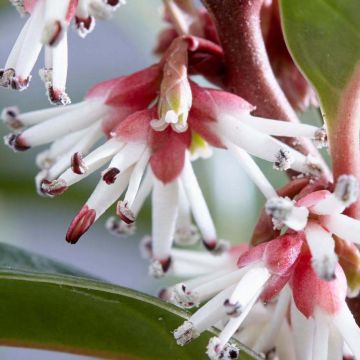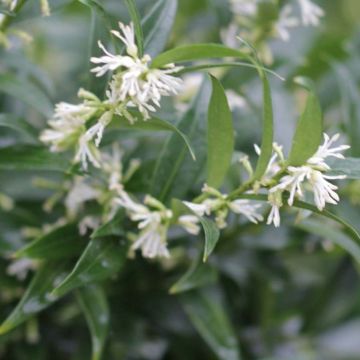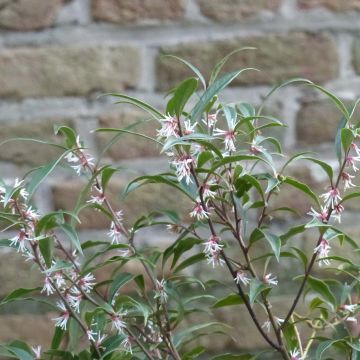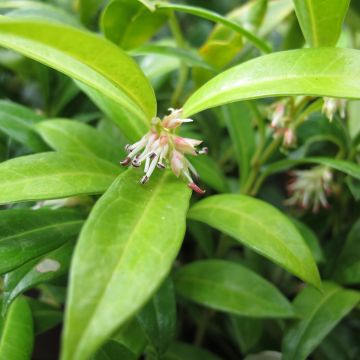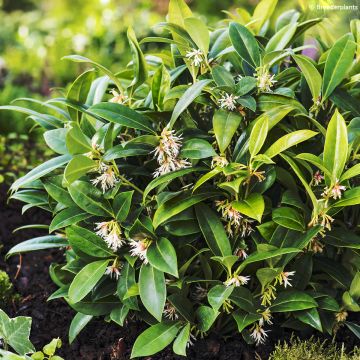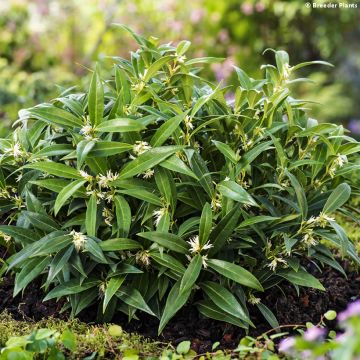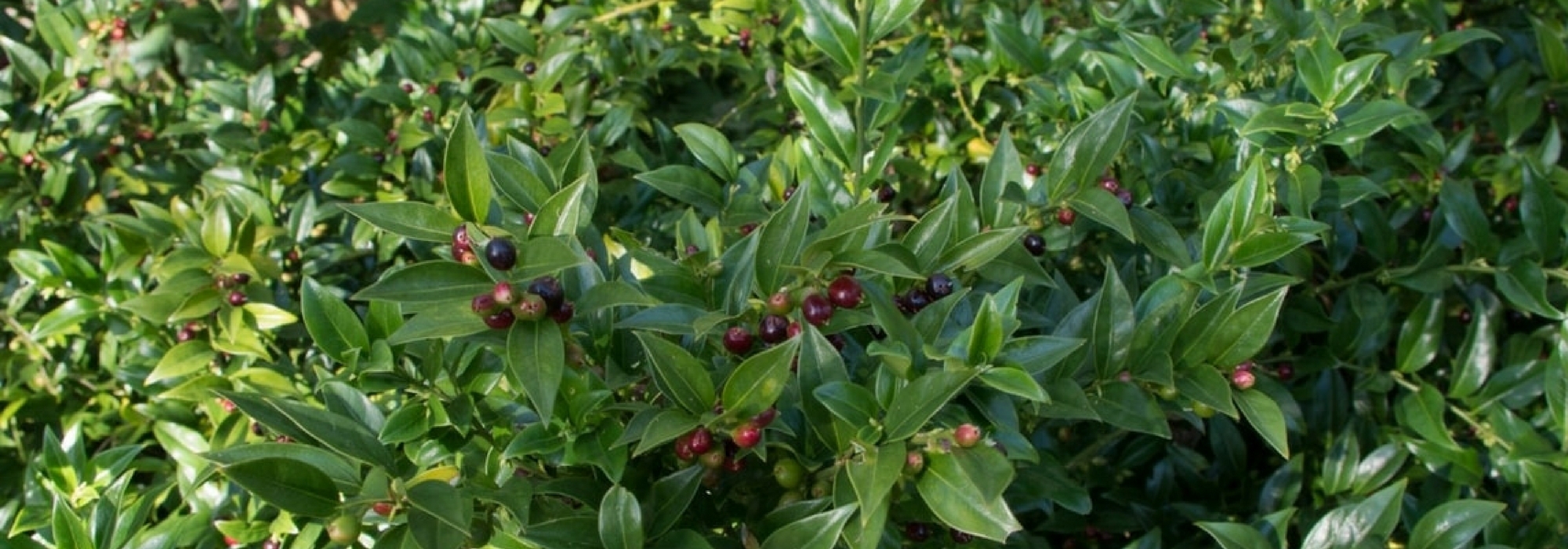
Sarcococca: how to grow and prune it
Contents
Sarcococca in a nutshell
- It is an evergreen bush for shady areas that enlivens the garden all year round.
- Its small flowers of a lovely pure white fragrance the garden in mid-winter.
- It tolerates even dry shade.
- It perfectly withstands pollution, making it an excellent city bush.
- Easy to grow, it grows slowly but requires no maintenance.
A word from our expert
Interesting for its glossy evergreen foliage of a beautiful dark green, its decorative berries, and especially for its delicately scented winter flowering, Sarcococca is the must-have bush in winter. This woodland shrub remains stunning when other plants are dormant. Still relatively unknown, it is, along with Daphne and Hamamelis, one of the few fragrant shrubs in winter: from November to February, its small white or pink flowers spread an extraordinary scent of jasmine and lily of the valley.
Discreet in the beautiful season, Sarcococca confusa, S. humilis or S. ruscifolia is content with little. It is the perfect ally for filling neglected and shaded areas, where few plants bloom.
It grows slowly but structures small spaces in winter. Its moderate size and dense silhouette allow for numerous uses: in borders, along pathways, as a low hedge, as ground cover, in groups, and even in pots near your entrance to fully enjoy its fragrance.
Accommodating, it is among the easy-to-grow shrubs in the garden, provided it is cultivated in non-calcareous soil and in shade. Very resistant to pollution, insensitive to diseases, and requiring little maintenance, it is essential in city gardens.
It pairs well with all sorts of plants, in shade or partial shade, even among tree roots. It is perfect for filling a woodland area where it can be combined with heather soil plants as well as more colourful foliage plants to contrast with its dark leaves: Camellias, Ferns, Hamamelis, Skimmias, Aucubas, or Azaleas, as well as with Hellebores and Snowdrops planted at its base.
Grow this shrub whose foliage somewhat resembles that of the olive tree, and it will surprise you by bringing a touch of spring to the garden as early as January!
Botany
Botanical data
- Latin name Sarcococca
- Family Buxaceae
- Common name Sarcococca
- Flowering from December to March
- Height 60 cm for the smallest varieties and up to 2 m at maturity
- Exposure partial shade, shade
- Soil type acidic (heather soil) or neutral
- Hardiness Below -15°C
Sarcococca is an evergreen bush belonging to the Buxaceae family. A close relative of boxwood, it shares the same tolerance for dry shade. This genus comprises around fifteen species of evergreen bushes native to cool, shaded areas of Southeast Asia, China, and the Himalayas. The most well-known, Sarcococca confusa, can grow over 2 m tall. However, there are other equally cultivated varieties : S. hookeriana, S. humilis, S. ruscifolia, and S. saligna.
Sarcococca naturally grows in thickets and humid mountain forests.
Sarcococca forms a compact, rhizomatous bush, producing numerous suckers. It establishes itself among tree roots, slowly but surely: with age, some running or suckering varieties (S. hookeriana) form vast colonies without becoming invasive. Interesting when nothing grows in the shade!
The plant develops in clumps, with its stems naturally growing from the base and widening over the years. Sarcococca has a dense, compact, and bushy habit, more or less spreading, reaching a maximum width of about 1 to 2 m at maturity: dwarf species, which are less cumbersome, can be planted anywhere. The size of these plants varies by species (60 cm for the smallest varieties) but never exceeds two meters in height; thus, Sarcococca can be used as a border plant, in low hedges, as ground cover, or to hide a wall. These are hardy species that grow very slowly: you will need to be patient for a few years to obtain a plant worthy of the name. However, flowering occurs even when the bush is young.
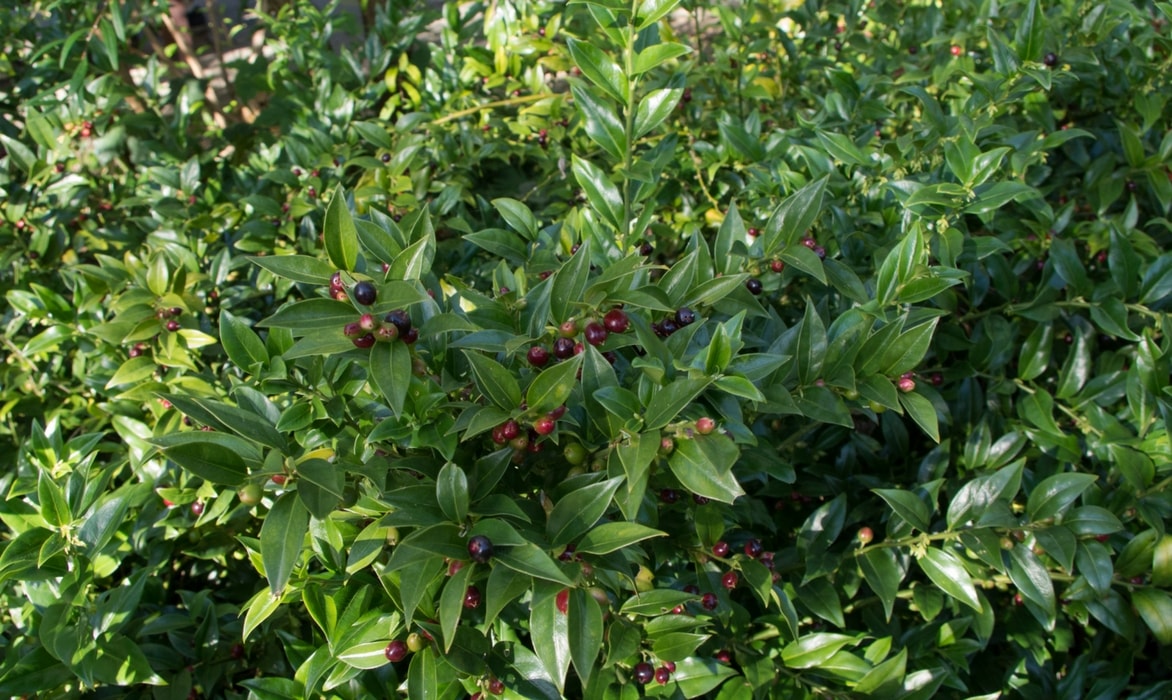
Sarcococca hookeriana humilis – Photo: Dinkum
The flowering is the main asset of Sarcococca. It is early and occurs even when it is freezing! It takes place from December to March in the form of small, fine white inflorescences measuring 3 to 5 mm long, distributed along the stems at the axil of the leaves. While the female flowers are very discreet, the male flowers, lacking petals, reveal large white stamens or those tinged with green or pink depending on the variety, with very bright yellow or pink anthers. Even though they are not extraordinary, they exude a powerful fragrance of jasmine, lily of the valley, or vanilla that perfumes the area around the plant. This highly fragrant flowering lasts for about 2 months, depending on the climate.
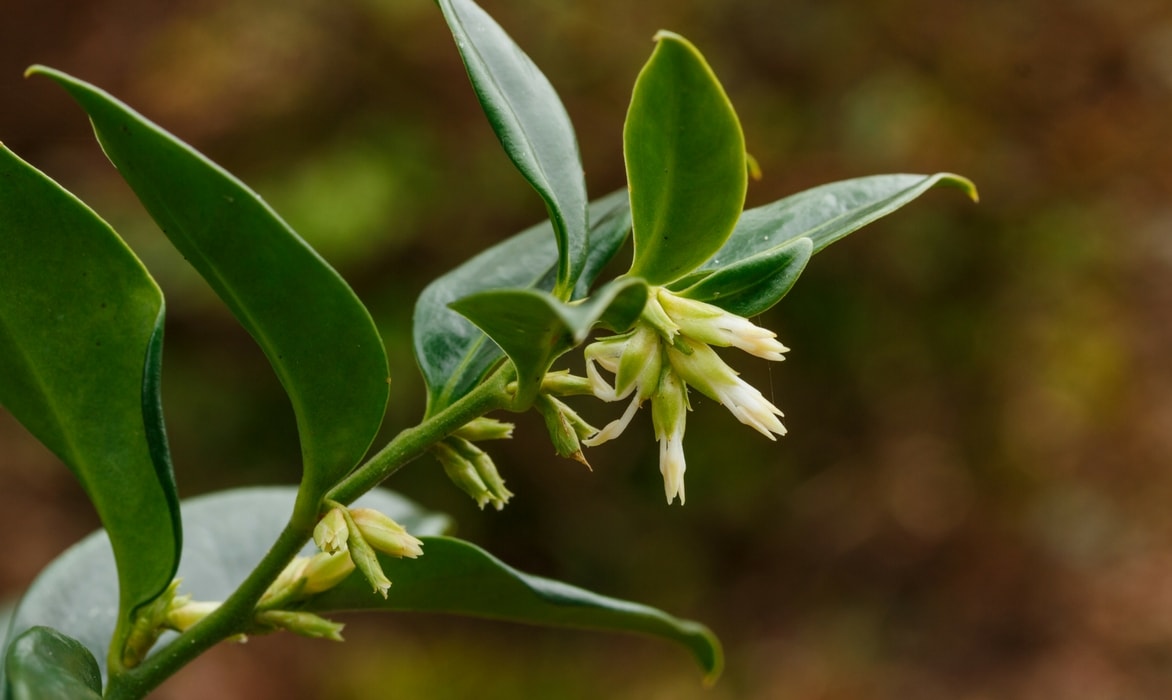
Flowers of Sarcococca confusa – Photo: Dominicus Johannes Bergsma
The flowers give way in autumn to non-edible red or purple fruits (or drupes) less than one centimeter in diameter that turn bluish-black in autumn. These fleshy, shiny berries sometimes coexist with the flowers, creating a lovely contrast. They resemble pearls or small olives that are highly appreciated by birds. This fruiting adds to the decorative interest of the bush, which remains attractive even after flowering.
In summer, it forms beautiful bushy clumps interesting for their foliage somewhat resembling that of the olive tree. These evergreen leaves are glossy, lanceolate to oblong, measuring 3 to 15 cm long, and are dark green in color.
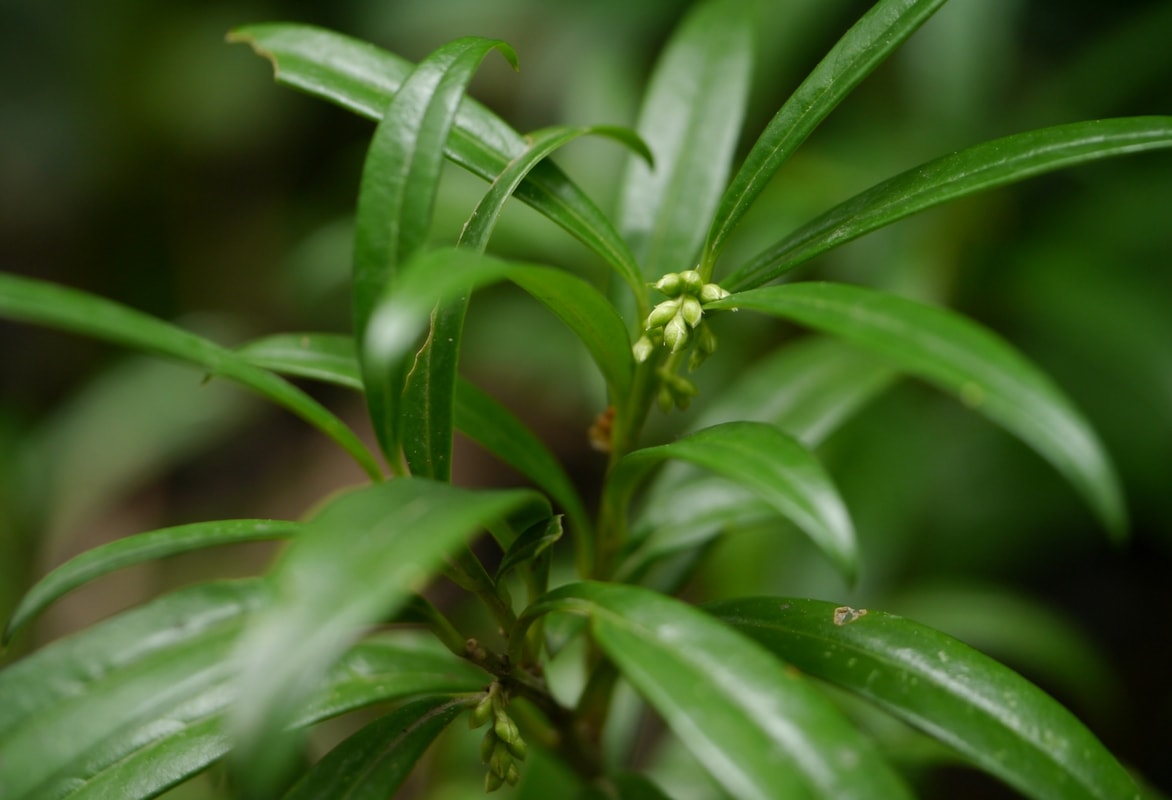
Sarcococca saligna – Photo: Dinesh Valke
Despite its thick foliage and robust clump, Sarcococca fears two things: full sun, especially south of the Loire, and limestone. It prefers rather acidic, cool but well-drained soils, as it hates having its feet in water. It adapts to soils riddled with roots. A partially shaded space, in woodland or under the dense shade of large trees, will suit it perfectly.
The only small whim of this low-maintenance shrub is to be planted sheltered from cold, drying winds to preserve its flowering. Occasional droughts do not pose a problem; a few summer waterings are sufficient if it should prolong.
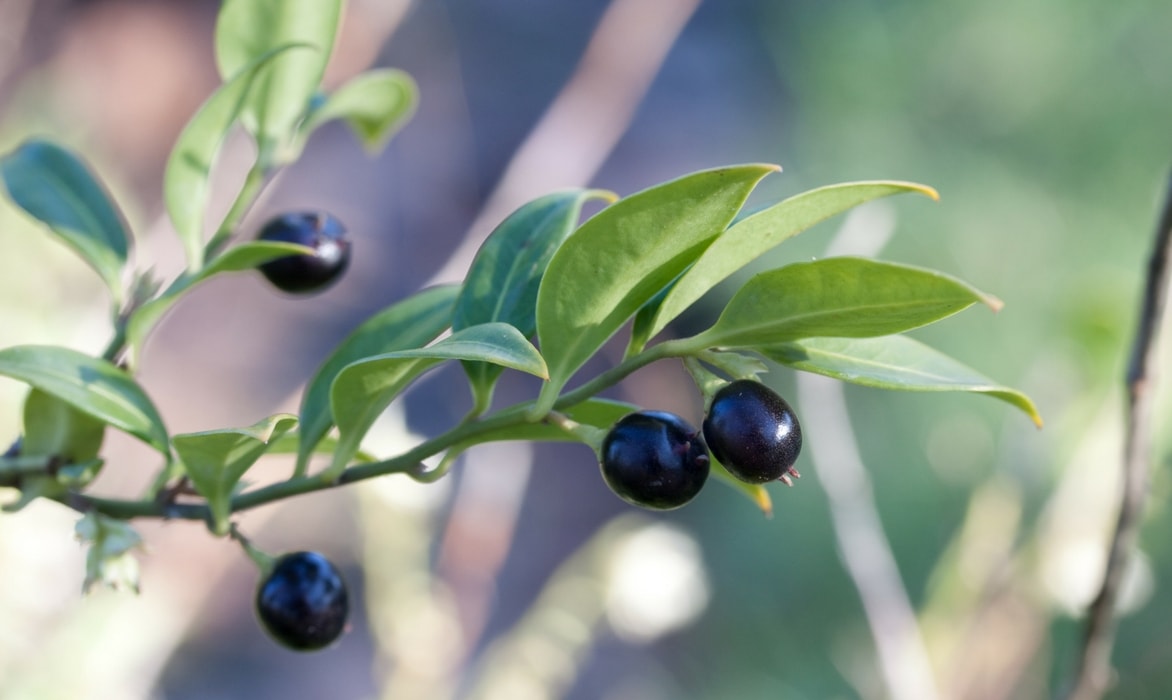
Fruits of Sarcococca hookeriana – Photo: Denis Prévôt
Sarcococca is very hardy and withstands temperatures below -10°C, down to -15°C, provided it is planted in a sheltered position. It can be found throughout France, with a preference for the oceanic climate. In cold areas, mulch its base during the first winters or in case of exceptional cold.
Easy to care for, Sarcococca tolerates pollution, dry shade, lack of care, and is resistant to diseases and pests. Note that some varieties, such as Sarcococca humilis, are very well suited for pot cultivation.
Read also
Sarcococca: 5 companion planting ideasSpecies and varieties
There are eleven species of Sarcococca as well as a few hybrids selected for their size and the colour of their flowering. Among the most common, which you can easily find in stores, are: Sarcococca confusa which can reach 2 m in height, Sarcococca humilis which has a compact rounded habit, and S. hookeriana, a spreading species, perfect for a bank.
- Sarcococca confusa or Sarcococca confusa : compact rounded bush. The evergreen clump is dense from the base. Its foliage is stiff and dark, and its flowering is highly fragrant.
- Sarcococca hookeriana: very close to S. Confusa, it is a rhizomatous trailing bush, which tends to spread more than the other species. It is therefore ideal as ground cover, sheltered from draughts. Native to the Himalayas, it is very cold-resistant. It was named in honour of Joseph Dalton Hooker and William Jackson Hooker, two eminent botanists who were directors of the Royal Botanic Gardens at Kew in England. It offers a highly fragrant cream-white flowering.
- Sarcococca hookeriana var. humilis or Sarcococca humilis: this is the most widespread cultivar. It takes the form of a dwarf bush. Prefer planting in groups for a ground cover effect. Its highly fragrant white flowers, tinged with pink, produce lovely dark blue berries.
- Sarcococca ruscifolia or Ruscus-leaved Sarcococca: it is quite little known and still rare in our French gardens. It owes its species name to the resemblance of its leaf to that of the Butcher’s Broom (Ruscus). It is a small dense bush with a globose habit and arching stems, which will not exceed 1 m in all directions after many years. Its growth is quite slow. With its compact habit, it structures small spaces in winter. Its evergreen foliage is dark green and shiny on the top, lighter on the underside. It produces lovely round red fruits in summer and has a highly fragrant flowering.
- Sarcococca saligna or Willow-leaved Sarcococca: its light green foliage, finer than that of other varieties resembles that of willows. Its winter flowering is almost odourless, an unusual trait for the genus. With a beautiful rather spreading but compact habit, it carries its large leaves like a coat of feathers cascading over its branches. Its discreet winter flowering is followed by small purple fruits, quite decorative.
- Sarcococca orientalis or Eastern Sarcococca: it is a small dense bush with a compact habit and arching stems, its growth is also very slow. It is suitable for small gardens. This particularly floriferous Chinese species shows an upright and compact habit and bears large evergreen leaves, dark green, elongated, thick, and shiny. In winter, clusters of small white flowers with pink anthers appear, exuding an extraordinary fragrance. They are followed by small red then black fruits, quite decorative.
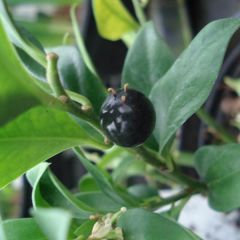
Sarcococca confusa
- Height at maturity 1,50 m
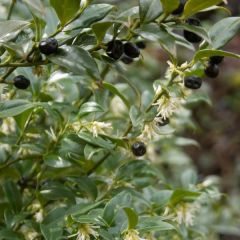
Sarcococca hookeriana
- Height at maturity 80 cm
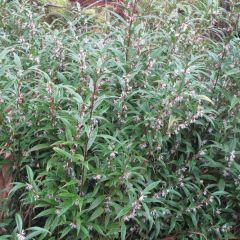
Sarcococca hookeriana var. digyna
- Flowering time February to April
- Height at maturity 90 cm
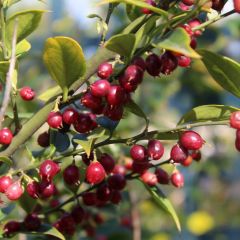
Sarcococca ruscifolia
- Flowering time February, March
- Height at maturity 1 m
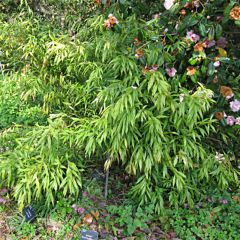
Sarcococca saligna
- Height at maturity 1,40 m
- Sarcococca hookeriana var. digyna ‘Purple Stem’: with young shoots shaded dark pink-purple and pink-washed flowers.
- Sarcococca ruscifolia var. chinensis: interesting with its beautifully arching branches, elongated oval leaves of a beautiful shiny dark green and its highly fragrant white flowering.
- Sarcococca ‘Winter Gem’: we love this small-sized hybrid with dense foliage and fragrant flowering throughout winter.
Discover other Sarcococcas
View all →Available in 2 sizes
Available in 2 sizes
Available in 2 sizes
Available in 2 sizes
Available in 2 sizes
Available in 1 sizes
Available in 1 sizes
Available in 1 sizes
Available in 1 sizes
Available in 1 sizes
Planting Sarcococca
Where to plant?
While it thrives best in oceanic climates, Sarcococca can be found throughout France. This is a fairly hardy bush that can withstand occasional temperatures of around -15°C. However, it should be planted sheltered from cold, dry winds that can damage its flowering. In cold areas, mulch its base during the first winters or in case of exceptional cold.
Sarcococca is so undemanding that it is often relegated to the dry, shaded corners of the garden. It does not tolerate lime, so place it in humus-bearing, rather acidic, cool but well-drained soil. While Sarcococca can be associated with heather soil plants, it also grows very well in neutral soil.
Sarcococca is cultivated both in borders and under trees, in low free hedges or as ground cover.
It is perfect when planted under large deciduous trees: these naturally provide the shade and drainage that Sarcococca loves.
It can be placed along walls, near a frequently used path, not far from the entrance or in a pot under a window, where it will perfume the air with its sweet flowering during the winter months. In small city gardens, Sarcococca can hide small walls while requiring little care.
It is unobtrusive and will not hinder its companion plants. It associates well with all sorts of plants, in shade or partial shade, even among tree roots; ferns, witch hazel, skimmias, aucubas, or azaleas.
When to plant?
It is planted from February to April or from September to November, after heavy frosts or extreme heat, and especially not when it is snowing.
How to plant?
Sarcococca is not very demanding, which makes its planting very simple:
- make a hole at least three times the volume of the root ball.
- It requires good drainage (its roots do not like stagnant moisture) of about twenty centimetres at the bottom of the planting hole: add compost or heather soil to the garden soil, and a little sand if necessary to lighten it.
- Spread an organic mulch to finish.
- Water abundantly immediately after transplanting and for two to three weeks. A few summer waterings are sufficient in case of prolonged drought. Once well-rooted, it is quite resistant to drought.
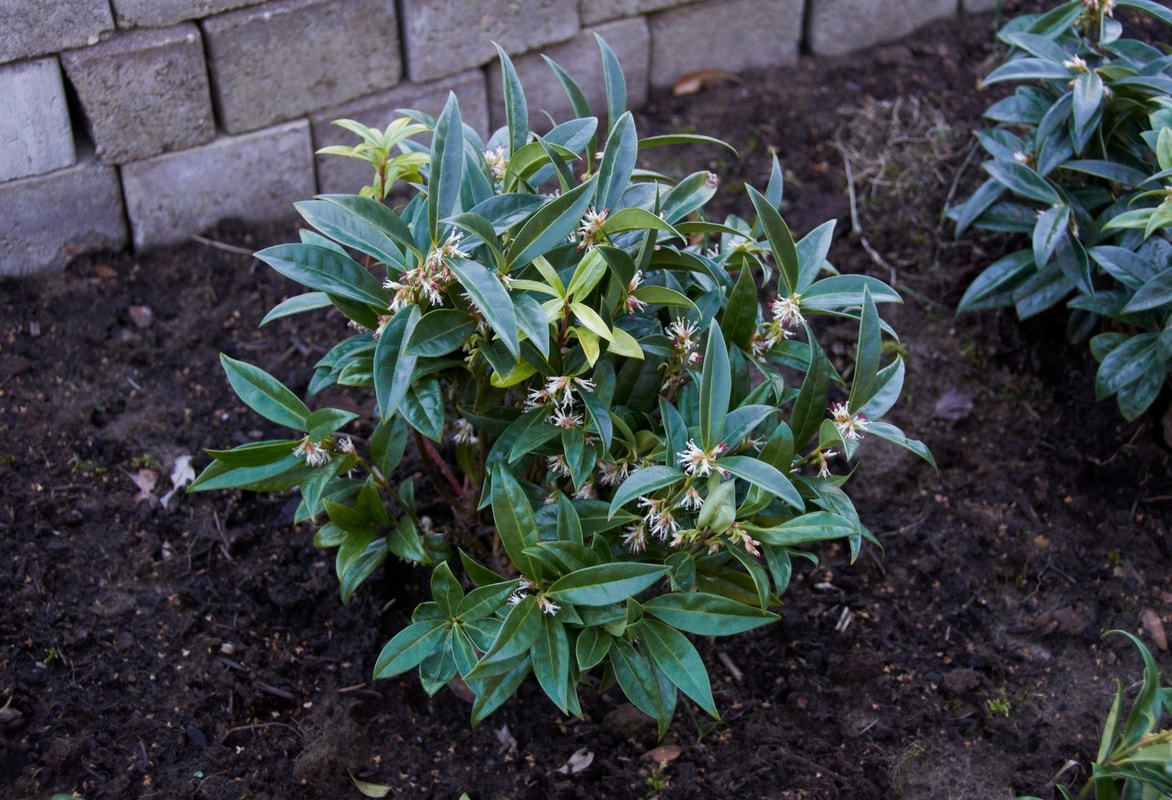 Planting – Sarcococca hookeriana humilis – Photo: Wouter Hagens
Planting – Sarcococca hookeriana humilis – Photo: Wouter Hagens
A single Sarcococca plant can be enough to create a beautiful effect, especially for the taller varieties and if mixed with other evergreen bushes. The lower, suckering varieties like S. hookeriana are perfect for slopes where they will multiply over the years. For a well-filled and fragrant slope all winter, prefer planting in groups.
Pot planting is common, in a container of about twenty litres filled with a mix of potting soil and 20% sand. Placed on a shaded terrace, near the house, you will enjoy its fragrance all winter.
→ Learn more in our article Growing Sarcococca in a pot
Care and Pruning of Sarcococca
It is a bush that requires little maintenance; it likes to be forgotten and grown tough.
Pruning is not essential: this bush grows slowly, just like dwarf conifers. If it takes on an unsightly shape: prune lightly after flowering to maintain a harmonious shape, but in this case, it will not produce any fruit.
Fertilisation consists of a surface application of compost in autumn.
For potted specimens, repotting every 5 years will be necessary.
Tough, it perfectly tolerates pollution, and it is never sick nor attacked by parasitic pests.
Multiplication of Sarcococca
By propagation by cuttings:
It is propagated in summer using semi-ripe shoots (that is, stems that are in the process of transforming from softwood to hardwood). Cuttings of 7 cm taken just below a bud should show a base of brown wood and a green growth tip. At this stage of development, the rooting of the taken stems is better for the establishment of the cuttings. They are stripped of their leaves on the lower part of the stem. These are buried two-thirds in a moist mixture based on turf. The mixture must never dry out completely. Overwinter in a frost-free place and then transplant in spring.
By layering:
Like propagation by cuttings, layering will allow you to easily obtain, quickly and at low cost, plants identical to the mother plant. Layering is a simpler and less tedious technique than propagation by cuttings as it often occurs spontaneously on the bush: mature Sarcococca produce low branches that naturally layer, meaning they tend to root when in contact with the soil.
This technique involves inducing the appearance and then the development of roots on a portion of stem, temporarily buried near the mother plant. In spring or early summer, bury long low branches in a trench 40 cm deep until they root. Separate the well-rooted suckers in autumn or the following spring and grow them in pots for a year before planting.
By division:
You can easily multiply Sarcococca by taking the clump offsets. At the end of winter, using a spade, cut the oldest offsets which you will immediately replant, taking care to water them well.
Association
An essential feature of winter scenes, Sarcococca pairs well with heather soil plants such as ferns, azaleas, Pieris, witch hazel, or rhododendrons. Like them, all appreciate acidic soils and will provide stunning combinations of flowers and foliage.
Versatile, Sarcococca adapts to all gardens and uses: as a low hedge alongside various bushes, or as a backdrop for the taller varieties. It can be combined with variegated, evergreen bushes like Aucubas, Daphne, or with colourful woods such as dogwoods.
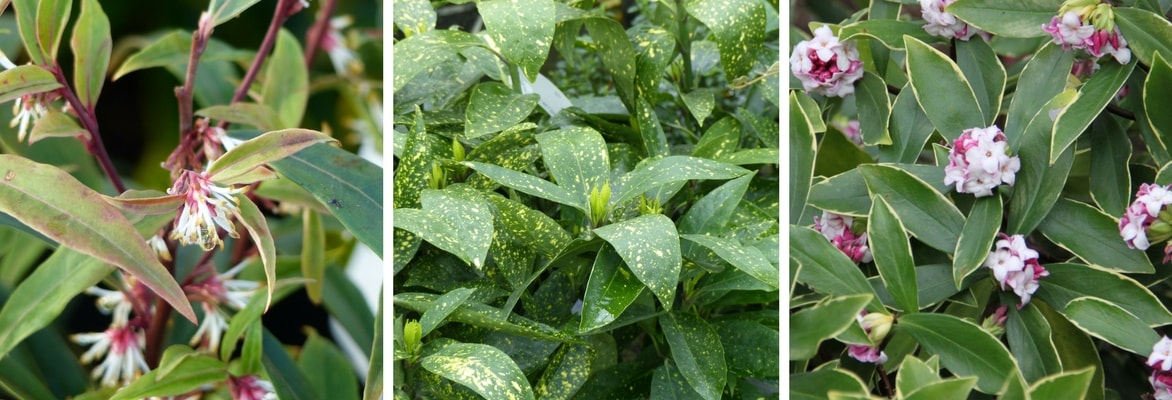
Sarcococca hookeriana digyna, Aucuba japonica variegata, Daphne odora aureomarginata
As a ground cover under large deciduous trees, it will provide persistent green spots throughout winter when the trees have lost their leaves. To enjoy its evergreen foliage and fragrance, plant it in a pot on a shaded terrace or near entrances. Paired with hellebores, winter heathers, heucheras, and small spring bulbs (daffodils, crocuses, wood hyacinths, snowdrops…), it will create compositions that are both fragrant and bright.
Don’t miss out on this bush that scents and brightens winter!
Useful resources
- The most beautiful range of sarcococca is with us!
- On the Promesse de Fleurs Blog, Michael’s article: Sarcococca hookeriana, a discreet bush.
- Advice sheet: Sarcococca: 5 ideas for association
- Video: The Sarcococca
- Subscribe!
- Contents































